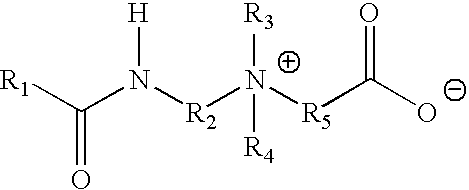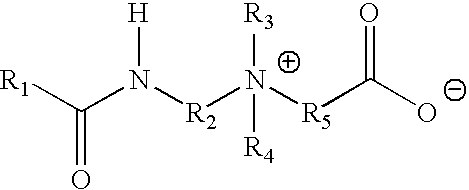Non-Damaging Fluid-Loss Pill and Method of Using the Same
a fluid-loss pill and non-damaging technology, applied in the direction of fluid removal, fluid removal, chemistry apparatus and processes, etc., can solve the problems of inhibiting removal, difficult and predictable cross-linking, and difficult to unload fluids from formations
- Summary
- Abstract
- Description
- Claims
- Application Information
AI Technical Summary
Benefits of technology
Problems solved by technology
Method used
Image
Examples
Embodiment Construction
[0022]In one aspect, the present invention discloses an additive for a “fluid-loss pill” that is based on a viscoelastic surfactant, which is capable of being used in a vast range of temperatures. In one embodiment, the well fluid may be used as a fluid loss pill. Furthermore, the well fluid of the present invention is stable at high temperatures (in excess of 350° F.). In some embodiments of the invention for instance, the fluid is stable at 300° F. for extended periods >72 hours and for >36 hrs at 320° F. When used as a fluid loss pill, the well fluid is compatible with oilfield heavy brines and does not require the addition of further fluid loss materials such as starch, sized salts, carbonate chips, mica or other particulates, though this well fluid is compatible and can be used with these materials.
[0023]The base fluid may be fresh water or an aqueous solution comprising mono, di or trivalent metal salts, ammonium or mixtures of these. For some applications, in particular where...
PUM
| Property | Measurement | Unit |
|---|---|---|
| density | aaaaa | aaaaa |
| static bottomhole temperature | aaaaa | aaaaa |
| concentrations | aaaaa | aaaaa |
Abstract
Description
Claims
Application Information
 Login to View More
Login to View More - R&D
- Intellectual Property
- Life Sciences
- Materials
- Tech Scout
- Unparalleled Data Quality
- Higher Quality Content
- 60% Fewer Hallucinations
Browse by: Latest US Patents, China's latest patents, Technical Efficacy Thesaurus, Application Domain, Technology Topic, Popular Technical Reports.
© 2025 PatSnap. All rights reserved.Legal|Privacy policy|Modern Slavery Act Transparency Statement|Sitemap|About US| Contact US: help@patsnap.com



